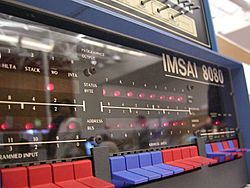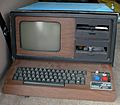IMSAI 8080 facts for kids
| IMSAI 8080 | |
|---|---|
| Manufacturer | IMS Associates, Inc., later IMSAI Manufacturing Corporation |
| Type | Hobbyist computer |
| Casing | Aluminum |
| Production | December 1975 |
| Discontinued | 1978 |
| CPU | Intel 8080/8085A @ 2 MHz/3 MHz |
| RAM | 256/4K bytes on a 4K board (static), 16K, 32K, 64K Dynamic RAM |
| Expansion | 22-slot motherboard S-100 bus |
| Software | First commercial supplier of Digital Research's CP/M (Control Program/Monitor), later followed by IMDOS, BASIC, FORTRAN |
| Storage | Optional cassette or
5 1/4" and 8" floppy drives, hard drives (CDC Hawk- 5 MB fixed, 5 MB removable |
The IMSAI 8080 was an early microcomputer that started being made in late 1975. It was built using the Intel 8080 (and later 8085) computer chips and the S-100 bus system.
This computer was very similar to its main rival, the MITS Altair 8800, which inspired it. Many people think the IMSAI was the first "clone" computer. This means it was designed to work just like another popular computer. The IMSAI machine used a special version of the CP/M operating system called IMDOS. It was designed, made, and sold by IMS Associates, Inc. (which later changed its name to IMSAI Manufacturing Corp). In total, about 17,000 to 20,000 units were made between 1975 and 1978.
Contents
History of the IMSAI 8080
In May 1972, a person named William Millard started a business called IMS Associates (IMS). He worked as a computer consultant and engineer from his home. By 1973, Millard officially created IMS Associates, Inc. He soon found money for his business and got several contracts, all for making computer programs.
In 1974, IMS was asked by a customer to create a "workstation system." This system would help car dealerships with their daily tasks. IMS planned a system that included a screen, a small computer, a printer, and special software. Five of these workstations would share access to a hard disk, which would be controlled by a small computer.
However, the development of this product eventually stopped. Millard and his main engineer, Joe Killian, then focused on microprocessors. Intel had just announced the 8080 chip. Compared to the older 4004 chip that IMS Associates had used before, the 8080 seemed like a much better idea. They started full development of the IMSAI 8080. By October 1975, they placed an advertisement in the Popular Electronics magazine, and people really liked what they saw.
IMS shipped the first IMSAI 8080 kits on December 16, 1975. In 1976, IMS changed its name to IMSAI Manufacturing Corporation because they were now mainly making computers, not just giving advice. By October 1979, the IMSAI company faced financial problems and stopped operating. The 'IMSAI' name was then bought by Thomas "Todd" Fischer and Nancy Freitas, who used to work for IMS Associates. They continued making the computers under the IMSAI name as part of their company, Fischer-Freitas Co. Even today, some support is still available for old IMSAI systems.
What the IMSAI 8080 Was Used For
The IMSAI 8080 computer was used for many different things, including:
- Helping small businesses handle their data processing (like keeping records).
- Systems for sending and receiving data, and for entering information into computers.
- Working on science projects and calculations.
- Teaching computer science and developing new computer ideas.
- Applications for banks and insurance companies.
- Uses in the Military and for general government tasks.
- As personal computers for people at home.
IMSAI in Movies
An IMSAI 8080 computer and a special device called an acoustic coupler modem were shown as tools used by the main character in the 1983 movie WarGames. This character was a hacker. An acoustic coupler was a device that let computers connect to phone lines by placing a phone handset into it. Even by 1983, this type of modem was quite old-fashioned. It was chosen for the movie so that viewers would immediately recognize it as the device that connected to the telephone.
Related Pages
- Altair 8800
Further Reading
- THE HISTORY OF IMSAI: The Path to Excellence, produced 1978
- Jonathan Littman, Once Upon a Time in Computerland: The amazing Billion Dollar tale of Bill Millard's Computerland empire, 1987, ISBN: 0-671-70218-1
Images for kids
-
IMSAI VDP-40 desktop computer from 1977-1979. It had an Intel 8085 chip, 32/64KB RAM, and two floppy disk drives (FDD) for storage.
See also
 In Spanish: IMSAI 8080 para niños
In Spanish: IMSAI 8080 para niños






